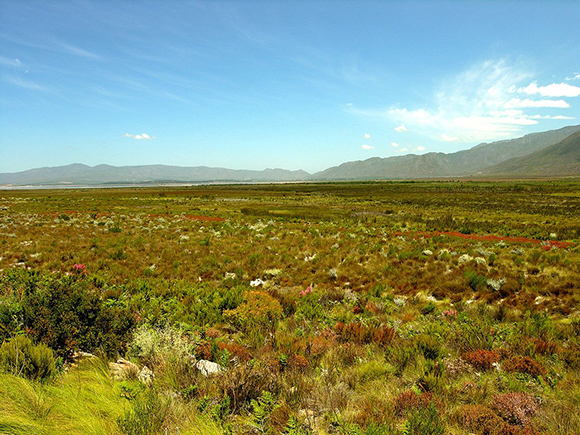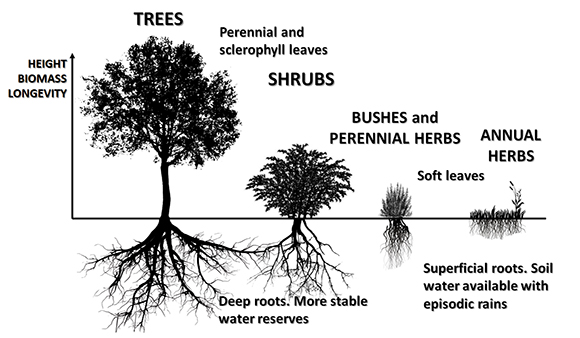Why are there so many plants?
Which characteristics of the environment and living beings can explain the great diversity of plants and life in general on Earth?

Margalef often spoke about the baroque of Nature. The enormous diversity of living things suggests that it is like Nature had void’s horror. Sandra Díaz, the second woman winner of Ramon Margalef Ecology Award, recalled this idea when receiving the prize. She studies plant functional types, which try to synthesize the enormous diversity of the plant world by grouping species on the basis of functional features (often linked to trend that are physiognomic or sometimes biochemical, physiological, etc. such are the weight of the seed, the foliar surface and thickness, the C/N ratio in leaves, etc.). Functional types are useful to make models.
Margalef often spoke about the baroque of Nature. The enormous diversity of living things suggests that it is like Nature had void’s horror.
Although insects, for example, present an overwhelming diversity, this can be imagined linked to the variety of resources (different types of leaves and fruits, other animals, decomposition residues, pollen, etc.). But plants all use the same resources: light, water and nutrients from the soil, and yet in a dry grassland you can find 40-60 species of herbs in 1 m2 and in a tropical forest 300 species of trees in 1 ha. If all employ the same resources, the the principle of competitive exclusion (according to which, if two species use the same resource, the most efficient one eliminates the other) does not works.
The classic explanation is that, at each point, the available resources and the environmental variables vary and that the life-cycles of the species develop in different ways and they reach different sizes and longevities. However, in the case of the herbs, we find them very close together, they have similar sizes, and they live all their cycle simultaneously. Therefore, the traditional explanation is incomplete.

With J. Peñuelas and F. Lloret, we proposed (Terradas, et al., 2009; Peñuelas, et al., 2011) that the niches of plants depend very much on temporary fluctuations in water availability. In the case of dry grasslands, the variation of conditions from one year to another causes different species to be favored and a high diversity is maintained. More generally, moisture fluctuations are much more frequent and important in the surface layers of the soil than in the deep layers. Average conditions, fluctuations and life cycle give a lot of possible of combinations that help to understand the non-compliance of the competitive exclusion principle. Interaction with other organisms also plays a role.
The division of plant biodiversity into functional types is useful in working with simplified models and it is also a first step to clarify the baroque of nature and the breach of the competitive exclusion principle.
To explain the high diversity of trees in tropical forests, Janzen suggested that the selection favors dispersal at a certain distance in order avoid giving facilities to specific phytophagous and pests. In addition, Peñuelas and his team have shown that in the composition of plants multiple nutrient elements are involved in varying proportions, and that also explains diversity: species have a different biogeochemistry depending on whether they are more or less flexible in this aspect, if they live together or not (if they do, competitive pressure causes their biogeochemical behavior to diverge) and if they have more or less similar genomes.
The division of plant biodiversity into functional types is useful in working with simplified models and it is also a first step to clarify the baroque of nature and the breach of the competitive exclusion principle. However, the diversity within each type demands a second level of explanation that must habitat consider average conditions, fluctuations, life cycles, biogeochemical organization and interactions with competitors, herbivores, parasites, etc.
Functional types are very useful in a wide range of topics (for example, in making fire response or climate change models), but the baroque of nature persists and each of the hundreds of thousands of plant species has its own characteristics, more or less plastic, that, to a large extent, are still unknown.
REFERENCES
Terradas, J. 2001. Mediterranean Woody plant growth-foms, biomass and production in the eastern part of the iberian Peninsula. Homage to Ramon Mrgalef, or why there is such pleasure in studying nature (J.D. Ros & N. Prat eds.). Oecologia aquàtica, 10: 337-349.
Terradas, J. 2001. Per què hi ha tanta diversitat de plantes? Iguals recursos, però moltes espècies. Mètode, 49: 27-33.
Terradas, J., J. Peñuelas, F. Lloret. 2009. The fluctuation niche in plants. Int. J. Ecol. Article ID 959702, 5 pp.
Peñuelas, J., J. Terradas, F. Lloret. 2011. Solving the conundrum of plant species coexistence: water in space and time matters most. New Phytologist 189: 5-8.







